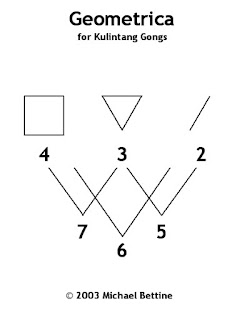Percussion Maps - Part 2

In this revised post, we'll look at how I reworked my drum set up back in 2004/5 and mapped out the possible patterns and melodic combinations. This was all based on Kulintang & Gamelan Gong set ups. Here are the Kulintang Gongs as I have them set up, followed by the note sequence: Here is the tuning order for the drums. While they are also in 2 rows, the tuning runs back and forth between the rows. The bass drums are also tuned to different notes, giving me 9 pitches to work with: Looking at the drums, I have various pitch maps available to me. The first is just going down and up the drums/scale (Fig. 1): Then I can break the drums up into two rows that are different scales (Fig. 2): I can also play 3-note chordal clusters (Fig. 3 & 4): Or 4-note chordal clusters (Fig. 5 & 6): With this set up, I thought of my playing in geometric shapes. I could do 2 & 3-note chords, arpeggios, and melodic lines. Next time we'll look at ...

